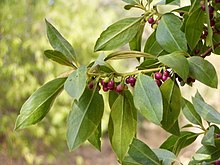Myoporum laetum
| Myoporum laetum | |
|---|---|
 |
|
| Leaves and fruit | |
| Scientific classification | |
| Kingdom: | Plantae |
| (unranked): | Angiosperms |
| (unranked): | Eudicots |
| (unranked): | Asterids |
| Order: | Lamiales |
| Family: | Scrophulariaceae |
| Genus: | Myoporum |
| Species: | M. laetum |
| Binomial name | |
|
Myoporum laetum G. Forst. |
|
| Synonyms | |
Myoporum laetum, commonly known as ngaio /ˈnaɪ.oʊ/ or mousehole tree is a plant in the family Scrophulariaceae endemic to New Zealand, including the Chatham Islands. It is a fast growing shrub, readily distinguished from others in the genus by the transparent dots in the leaves which are visible when held to a light.
Ngaio is a fast-growing evergreen shrub or small tree which sometimes grows to a height of 10 metres (30 ft) with a trunk up to 0.3 metres (1 ft) in diameter, or spreads to as much as 4 metres (10 ft). It often appears dome-shaped at first but as it gets older, distorts as branches break off. The bark on older specimens is thick, corky and furrowed. The leaves are lance-shaped, usually 52–125 millimetres (2–5 in) long, 15–30 millimetres (0.6–1 in) wide, have many translucent dots in the leaves and edges which have small serrations in approximately the outer half.
The flowers are white with purple spots and are borne in groups of 2 to 6 on stalks 7–15 millimetres (0.3–0.6 in) long. There are 5 egg-shaped, pointed sepals and 5 petals joined at their bases to form a bell-shaped tube 3.5–4.5 millimetres (0.1–0.2 in) long. The petal lobes are 4.5–5.5 millimetres (0.18–0.22 in) long making the flower diameter 15–20 millimetres (0.6–0.8 in). There are four stamens which extend slightly beyond the petal tube and the ovary is superior with 2 locules. Flowering occurs from mid-spring to mid-summer and is followed by the fruit which is a bright red drupe 6–9 millimetres (0.2–0.4 in) long.
Myoporum laetum was first formally described in 1786 by Georg Forster in Florulae Insularum Australium Prodromus. The specific epithet (laetum) is a Latin word meaning "happy".
...
Wikipedia
